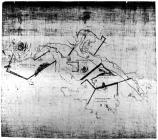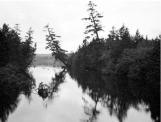1
Puget's Sound Agricultural Company Map19th Century, circa 1850s
Craigflower, View Royal, Victoria, Canada

2
For 2500 years prior to being sold to the Hudson Bay Company the land at Craigflower was used by the Kosapsom People part of the present day Esquimalt people. The Schoolhouse site was named Kosapsom, and it was often used by the meetings of the local chiefs. In order to increase their strategic position, the natives had made a small hill, which could be used as a lookout. As well as being a strategic position, natives fished for the coho salmon here, which are the only salmon to run the Gorge Waterway.The local chiefs sold the land in 1850, but that was not the end of their involvement with the farm. Native labourers, including Polly and Lucy, Agnes Mackenzie's two house servants, were an integral part of the establishment and maintenance of the farm. Craigflower Schoolhouse is presently located on the site of the original native village, so as a consequence various archaeological excavations have been preformed over the past seventy-six years since the site was developed into a heritage site by the Native Sons and Daughters, a society whose membership was the first generation of European settlers that was born in British Columbia. One former Craigflower pupil fondly remembers digging up native artifacts at recess in the schoolyard. The most significant artifact found at the site to date was a microblade which indicates that the site was being used prior to 4000 years ago when this technology went extinct..
3
Portage Inlet from Craigflower Bridge19th Century, Circa 1860
Craigflower, View Royal, Victoria, Canada
 Credits:
Credits:I-58288
4
The original land purchases were made in 1850 by James Douglas, the Hudson Bay Company chief factor, and later colonial governor, with the native tribes from Victoria to Sooke, including the land which became Craigflower, but is now part of the districts of Saanich , View Royal and Esquimalt. The payments for the land were given in the form of Hudson Bay Company blankets, clothing, and tobacco ropes. By including the phrase "to be the property of white people forever," Douglas ensured that the treaties were more specific, and less negotiable than their counterparts in the rest of Canada. Most of the bands received goods totalling the one time amount of about 30 dollars, which would be about equivalent to what James Stewart, the farm steward at Craigflower was being paid as his annual salary.7
Often the native labours were paid by what was called the "truck" system. Since the currency had not yet been decided upon for Vancouver Island, the American dollar and English pound were both being used, in return for their labour the natives would be paid with rations, tobacco ropes and Hudson Bay Company blankets. The value of a blanket was determined by the number of dark blue stripes on it, anywhere between two and five, similar to having a bar code today. The more stripes, known as points, on the blanket indicated the sizes of blankets, and so the natives quickly learned to identify with this system. Kenneth McKenzie did not like to pay a lot for the blankets, and as a consequence would order the least expensive blankets with which he could to pay his labourers.8
Hudson Bay four point blanket used at Craigflower as pay for the native labourers.13 August 2006
Craigflower, View Royal, Victoria, Canada

9
Portage Inlet from Craigflower Bridge19th Century, Circa 1860
Craigflower, View Royal, Victoria, Canada
 Credits:
Credits:I-58288
10
John Adams describes the history of the farm prior to the arrival of the Europeans11 February 2007
Craigflower, View Royal, Victoria, Canada


